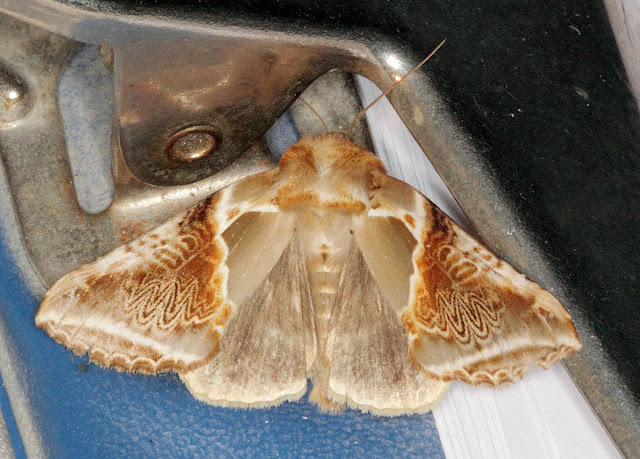 |
| Moth trapping on Keston Common, 2 July 2011. Sitting around the trap. |
After a
trip out to Riddlesdown on Saturday morning, at sunset I went to Keston Common, where a group of experts were setting up some portable moth traps. This exercise was run jointly by
Butterfly Conservation and Bromley Countryside Services, represented by Judy John. The chief moth expert was Paul Sokoloff, whom I last saw giving an
illustrated talk on moths at
BEECHE.
A moth trap is very simple. It consists of a light over a box, with something to slow the exit of the moths and some egg-boxes for them to rest on at the bottom. Away from civilisation, a generator powers the light, and this is usually put at the end of a long cable because it is noisy. (If you put one in your back garden you can use the mains supply.) Ultraviolet light attract insects best, and white light lets the trappers see the moths. You need both, and they can be separate or combined in one bulb. The whole thing is usually put on top of a white sheet, so that if any moths land outside the box they can be seen and won't be accidentally trampled.
 |
Midge, Chironomus luridus. Keston Common moth trap, 2 July 2011.
Not a moth.
I was pleased to find when I looked this up later that it doesn't bite |
As darkness fell, bats began to swoop around, and soon afterwards insects began to arrive at the traps. The photo at the top is blurry, but captures the atmosphere quite well. There were not only moths, but midges, caddis flies, wasps and craneflies. Small groups of people moved through the darkness from trap to trap, checking out the arrivals.
There was some coughing during the session. Apparently this is not uncommon, and is caused by all the wing scales in the air, too small to be seen but big enough to be an irritant. They come off quite easily. "If there's lots of coughing, it's a good night for moths," say the experts.
I took plenty of photos, and sometimes I managed to scribble down what I was photographing. The traps and groundcloths make pretty messy backgrounds, but I was in too much of a hurry to capture all the insects to do a better job. Next time I might take fewer photos but make them look more aesthetic. I also think that the camera's flash makes them look more bright and shiny than they do in life, and perhaps more colourful, but I can't see how to get round that without kidnapping them and keeping them until the light of the next day. But here are some that came out reasonably well. All taken with an EOS 60D and 100mm macro lens.
 |
| Buff Arches, Habrosyne pyritoides; almost under a clipboard. Keston Common moth trap, 2 July 2011. |
 |
| Mottled Beauty, Alcis repandata. Keston Common moth trap, 2 July 2011. |
 |
| Treble Brown Spot, Idaea trigeminata. Keston Common moth trap, 2 July 2011. |
 |
| Common Emerald, Hemithea aestivaria. Keston Common moth trap, 2 July 2011. |
 |
| Buff Footman, Eilema depressa. Keston Common moth trap, 2 July 2011. |
 |
| July Highflier, Hydriomena furcata. Keston Common moth trap, 2 July 2011. |
 |
| Stenoptilia pterodactyla, a plume moth. Keston Common moth trap, 2 July 2011. |
 |
| Udea prunalis. The antennae are typically held over its back like this. Keston Common moth trap, 2 July 2011. |
 |
| Common White Wave, Cabera pusaria. Keston Common moth trap, 2 July 2011. |
 |
| Norwegian Wasp, Dolichovespula norwegica. Keston Common moth trap, 2 July 2011. |
Another non-moth to finish. One of the group was stung by one of these when moth trapping last year.












Thank you for this interesting post, it's reminded me to get my moth trap out, hopefully this weekend!
ReplyDelete